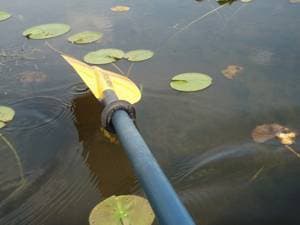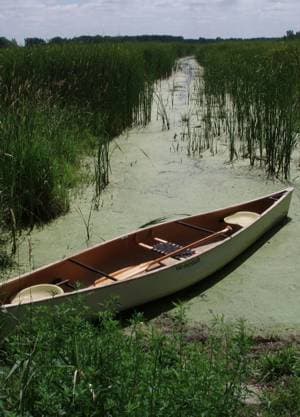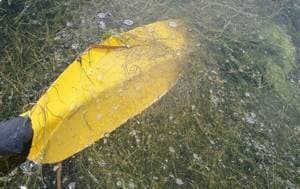Paddlin' in the Wind and the Weeds
There are times when a textbook paddling style doesn’t always seem to work. The rhythmic side-to-side stroke using a rotating torso instead of shear arm power just doesn’t seem to be working. Most of us, through trial and error, eventually work out a stroke, or series of moves that produce the desired result, namely, getting the canoe or kayak to move in the direction we want it to, regardless of what the wind is doing – or what other contrary factors are involved.

Have you ever tried to cross a bay with side or forward quartering winds? Quite the struggle sometimes, even with a rudder. Without one, it can be very tiring, indeed. I’ve found it necessary sometimes to only paddle on one side, the downwind side of my boat, when combating opposing winds. It takes a strong arm to keep the bow pointed in a desired direction (not always the direct to the other side, either).
I’ve found that for stability, I’ve had to shift my grip on the paddle off to one side making one long blade reach a broad sweeper blade and other, shorter reach, a power/balance blade. The long reach becomes a directional blade in that it sweeps the bow back into the wind, while the “short” reach offers a little more power and some counter balance against a forceful wind.
Such biased paddle strokes, either the one-side-only or the long-short reach method are usually last resorts after more common wind-correction techniques fail.
Oftentimes a quartering or broaching wind can be countered, in a kayak anyway, by leaning the craft to the upwind side. This is accomplished by lifting the downwind side of the kayak with one’s knee. This brings the keel around towards the windward side, tipping the boat downwind along the keel. It makes it easier to keep the boat into the wind without compromising the paddling stroke as suggested above. When the paddler counterbalances the lean of the boat with his/her body, the kayak tends to stay on line and track better. It can be a tiring effort but certainly less so than fighting the wind or adding miles to your route by facing into the wind.
There are times when I will also drop my rudder, not with the intention of adjusting my course but enabling it to act similar to a skeg. That extra resistance in the water can minimize the boat’s lean and aid in steering a desired course.
Sometimes it’s not the wind that impedes forward progress, it’s thick water! By that I mean a bay or lake full of seaweed or thick bottom growth. I know many a lake in my region of south-central Minnesota that are consider poor canoeing lakes because they are just too darn weedy.

Naturally paddling free and clear of obstacles that slow your glide or make it hard to get a good clean purchase with your paddle takes the fun out of kayaking or canoeing – or does it? It certainly decreases the ease at which you can paddle. It also limits the maneuverability of your boat, but on the positive side, it can open up many more bodies of water to exploration and discovery. Some of the best birding I’ve ever experienced has been in water deemed “terrible for paddling!”
For some lakes, the challenge is merely finding a clear corridor out to open water. Most natural resource departments will make access to lakes possible literally by cutting a swath through a dense “forest” of reeds. These can be quite long and then only expose one to a shallow, weed-filled lake that limits paddling anyway.
Most shallow lakes contain a variety of weeds, with milfoil and water lilies being the most common. Water lilies at least cover only the surface enabling a canoe or kayak to glide through with minimum effort. It’s the vinelike milfoils and other thick-growing weeds that form thick mats on the surface and remain an entangle mess below water that really slow a boat down.
I’ve found that there are two methods that work to help pull a canoe/kayak through such growths without too much trouble and without a lot of noise and commotion (we’re still trying to wildlife/bird view here, remember?).
The first method is what I call the “pause and pull” method. This is where you bring your paddle back to its most aft position in the stroke and then pause, just for a second, holding the blade in a nearly vertical position. Quite simply you are allowing any clinging weed strands to slip off as the boat continues to glide forward. Otherwise you can rake up weighty weed stems or kelp fronds if you pull the paddle up too quickly – especially if you are paddling with a normal power or touring stroke.
There are times when the weeds are so thick you can hardly get your paddle into the water in the first place. Should you get in such a “thicket” without being able to back out, there is a stroke and blade angle that can carry you through a short distance back out to more open water. I call it the skimmer stroke.
The skimmer stroke literally scrapes across the water surface, using only about fifty percent of the blade for purchase. There is enough resistance from the water, and more so from the surface weeds to help maintain a forward motion. Granted, this is slowly and marginally efficient style but at least you won’t feel you are adrift in the Sargasso Sea with slack sails.

In the case of water lilies, the broad, disc-like leaf pads are not the problem, but rather the long stalk trailing out from the center of the leaf that gets entangled in the blade. Simply using the “pause and pull” method negates that nuisance when paddling the lily pads.
Sometimes these same strokes can work when paddling in a very shallow, silt/mud-bottomed waterway. A direct stroke into the gooey mud or silt can stop a paddle in its tracks. The pause/skimmer technique can sometimes help you glide over such shallow spots, hopefully until you reach deeper water and before you get mired in the muddy soup.
These may be novice approaches to paddling in such conditions but they do work. Granted I get tired faster when dealing with such resistance for several hours but so far the rewards have been worth it. Additionally it gives your arms a good workout, too!
And always remember: The challenge of paddling on lakes with reed-lined shores or choked with weeds is often offset with great scenery and superb wildlife viewing.
Related Articles
Even though they are flipping over, missing their gates and failing their maneuvers, they still look…
In this video, we're going to look at five kayaking tips that will help make you a better paddler, or…
Most paddlers will develop a forward stroke that is powerful enough to get them where they need to go,…
Let's take a look at one of the strokes in the bracing family at the entry level. We have done High…



